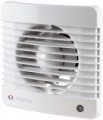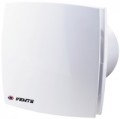Air flow (extraction)
This parameter describes the amount of air that the fan can pass through itself per hour when operating in extraction mode (see "Type"). It is one of the key characteristics of any extractor fan — it characterizes the overall performance and suitability of the unit for a particular room.
When choosing a fan for
maximum performance, two main indicators must be taken into account — the volume of the room and the air flow rate. The volume can be found by multiplying the area of the room by the height of the ceilings: for example, for a room of 12 m² in a residential apartment with standard ceilings of 2.5 m, this figure will be 12x2.5=30 m³. The air flow rate describes how many times per hour the air in an enclosed space must be completely replaced for ventilation to be sufficiently effective. This multiplicity is different for different types of premises: in particular, for the kitchen, it is 6-8, for the bathroom — 8-10, etc. More detailed values be found in specialized sources, in particular, sanitary standards. And the minimum required fan performance is calculated by multiplying the air volume by the air exchange rate. For example, if we have a bathroom with an area of 4 m² with the same ceiling of 2.5 m, then the volume of air in it will be 4x2=10 m³; Considering that the minimum air exchange rate for bathrooms is 7, for this room we need a fan with a capacity of at least 70 m³/h.
Rotational speed
The nominal fan speed during operation.
The rotational speed is one of the factors affecting the performance and, consequently, the overall efficiency of the fan. At the same time, this factor is far from being the only one. A lot also depends on the design of the blades, their number, the diameter of the impeller, etc. Therefore, fans with the same speed can differ significantly in capabilities, and you should pay attention primarily to performance.
At the same time, the rotation speed still has a certain practical significance. On the one hand, faster fans produce more noise; this drawback can be compensated to a certain extent by design tricks, but they, in turn, noticeably affect the price. On the other hand, to ensure the desired level of performance, lower-speed fans must either have impellers of a larger diameter (which accordingly affects the dimensions, and in most cases, the installation size) or, again, use design tweaks that affect the price.
Supply voltage
The voltage required for the operation of the fan, more precisely, the power standard for which the device is designed.
—
230 V. Standard voltage of single-phase household power mains. Such mains are used everywhere, both in residential and office, auxiliary, technical, etc. premises. At the same time, the power of this type of mains is quite enough even for fairly efficient fans, and the connection does not cause difficulties. Therefore, most modern units use this option.
—
400 V. An industry standard generally associated with high-performance equipment; increased voltage and a three-phase power format (instead of single-phase) allows you to provide a very high power supply. At the same time, the power consumption (see below), even for very efficient extractor fans, is usually not so high that a 400 V power supply is really necessary for them; and such mains are found much less often than 220 V ones, mainly in technical and industrial premises. Therefore, three-phase power is usually used in fans of the "industrial" level, not to provide the necessary power, but to facilitate connection and remove part of the load from 230 V networks.
—
12 V. 12 V DC power supply. This voltage is not found in household mains, therefore, an external adapter for 230 V is used for operation. The meaning of this type of power supply is that at low power is muc
...h safer than 230 V: in most cases, a healthy person does not notice a 12 V current at all. Therefore, 12 V fans are considered the best option for places with high humidity — bathrooms, showers, etc. — where the risk of electrical injury in case of violation of the insulation of the unit is especially high. The design of such models is usually such that the power supply can be placed quite far from the device, in a place with normal humidity. Of course, the presence of water protection is mandatory even in this case, but a low supply voltage can be an important additional guarantee of safety.Perimeter suction
A suction system that draws in air through a series of holes around the perimeter of the air intake. This design provides high suction efficiency and, at the same time, allows you to apply advanced design solutions to the device. Perimeter suction is characteristic mainly of models of the upper price range.
Cover height
The size of the decorative fan cover in height.
For details on the features of such panels in different types of fans, see "Cover diameter". The same size is indicated in cases where the panels are in the shape of a square or rectangle (see "Cover shape").
Cover width
The size of the decorative fan cover in width.
For details on the features of such panels in different types of fans, see "Cover diameter". The same size is indicated in cases where the panels are in the shape of a square or rectangle (see "Cover shape").
Cover thickness
The size of the decorative fan cover in thickness.
This parameter describes how much such a panel protrudes above the surface of the wall or ceiling on which the fan is installed. For more information about the general features of decorative panels in different types of fans, see "Cover diameter".
Mounting depth (duct)
Mounting depth of the fan with a standard installation method.
This parameter describes how deep into the duct the unit (or its parts in the case of surface-mounted models, see "Type") is placed during installation. Knowing the mounting depth, it is possible to assess the suitability of the selected model for a particular installation location: a flat section at the very beginning of the duct must be no less than the installation depth of the selected fan.
The smallest value of this parameter is typical for some overhead models of fans: in them, the main part of the structure is outside, and usually, only 2-3 centimetres are required for installation. And most of all, hidden units require space (see "Type").

